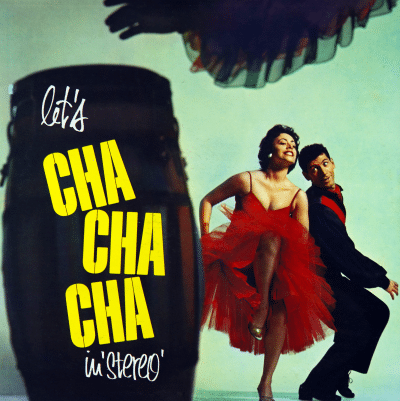.
.
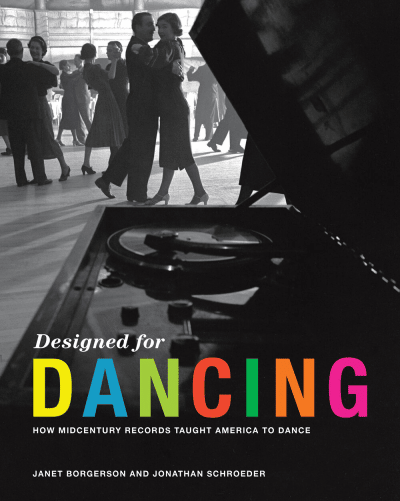
Designed for Dancing: How Midcentury Records Taught America to Dance [MIT Press]
by Janet Borgerson and Jonathan Schroeder
…..
…..In our book Designed for Dancing: How Midcentury Records Taught America to Dance, we tried to provide a comprehensive overview of dance records and their glorious covers. Cha-cha-cha represented one of the most popular genres – we’ve collected hundreds of cha-cha-cha records, from well-known jazz musicians to obscure and often unidentified studio bands. Here, we include a few that didn’t quite make the final cut for our book.
…..Cuban violinist Enrique Jorrín gets credit for creating the cha-cha-cha with his composition, “La Engañadora.” Little could he know that his innovative simplified syncopation would spawn such classic numbers as “Voulez-Vous Cha Cha” from Tito Rodriguez, “Glow Worm Cha Cha,” found on Hammond Gone Cha-Cha – for organ music fans – and, years after the cha-cha-cha craze had cooled, “Cha Cha Heels” by Eartha Kitt and Bronski Beat. Although often compared to the mambo, the Latin precursor in the world of dance crazes, “the cha-cha-chá was in many ways the opposite of the mambo: rather than brass, it relied on strings and flute, it was light, crisp, and melodic. The rhythm was catchy, and compared to the pulsating mambo, simple,” according to historian Louis A. Pérez, Jr. Although the basic dance seems straightforward, the cha-cha-cha incorporates numerous complicated moves, such as the Fan, the Alemana, the Hockey Stick, the Time Step, and the Spiral, as described by influential dance teachers Doris and Pierre Lavelle.
…..Cha-cha-cha became an incredible commercial success, and dozens of popular songs were reworked in cha-cha-cha style – from “Tea for Two Cha-cha-chá” by Tommy Dorsey to “The Christmas Song Cha Cha” by Hugo Winterthalter. Cha-cha-cha records proliferated, with the big Latin stars – Perez Prado, Tito Puente, Tito Rodriguez, Xavier Cugat – contributing to the pile. Although New York and Miami were centers of cha-cha-cha, its popularity spread from coast to coast, and profoundly influenced the popular music of the day.
…..Many cha-cha-cha albums provide pithy histories. Others deliver dance instructions. Cha-cha-cha album cover design often features glamorously, seductively posed women who animate Latin-themed props – say, maracas, a palm tree, and tropical hues. Album titles offer various permutations of the name: Cha Cha, cha-cha-cha, chachachá. Perhaps like the dance, the name adapts, fitting in to Manhattan dance floors, Catskills resorts, Miami bodegas, and Los Angeles clubs. Cha-cha-cha anyone?
.
-Janet Borgerson and Jonathan Schroeder
.
Click here to view the book’s website
.
The authors have created a “Cha Cha Cha” Spotify playlist that is accessible at the conclusion of this feature.
.
.
___
.
.
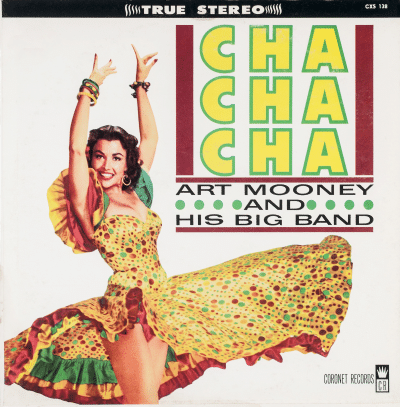
Cha Cha Cha
Art Mooney and His Big Band
Coronet CXS 138; 1959
.
…..Cha Cha Cha by Art Mooney and His Big Band represents but one example of a record released in five different versions, on several different record labels. The classic cover displays a dancer cha-cha-cha’ing with her arms overhead and full-skirted dress twirling magnificently, its bright red and green polka dots adding to the spinning effect of her pose that exposes her upper thighs. (With her ruffled skirt and sleeves, she bears some similarity to the female dancing emoji.)
…..The liner notes provide detailed and compelling technical descriptions of the Telefunken microphones, Ampex tape recorders, and Westrex disc cutter used to produce the record. They are a bit less informative about the music, expressing tepid enthusiasm: “Here for your enjoyment is the dancing beat of the Cha-Cha, made all the more danceable by the unique and inimitable sound that is Art Mooney.” Songs include “Who’s Sorry Now,” “Hand Across the Table,” and “Shine on Harvest Moon,” all presented in an odd mix of cha-cha-cha and big band sound. Mooney, who started out in Detroit, had a string of postwar hits for MGM Records, including “I’m Looking Over a Four Leaf Clover,” “Baby Face,” and “Bluebird of Happiness.” His signature musical elements included banjo, glockenspiel, and the uses of group singalong choruses. He enjoyed a long career, and played a minor role in the 1990 film The Adventures of Ford Fairlane, in which a key, if somewhat obscure, plot element concerned a data disc hidden under his Hollywood Walk of Fame star.
.
.
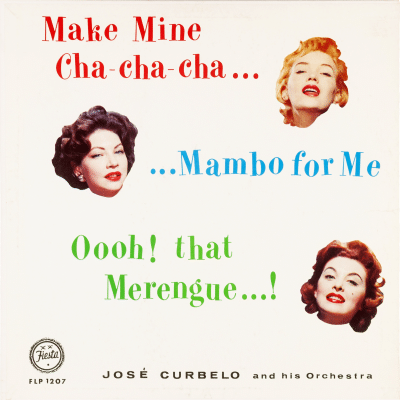
Make Mine Cha-Cha-Cha…Mambo for Me, and Oooh! that Merengue…!
Jose Curbelo and His Orchestra
Fiesta FLP 1207; 1956
.
…..Talking heads of a blond, a brunette, and a redhead seem to be saying Make Mine Cha-cha-cha…Mambo for Me, and Oooh! that Merengue…! on the cover of José Curbelo and his Orchestra’s album. Perhaps they represent the cerebral as well as the bodily pleasures of dance. In any case, the cover imagery offers another example of hidden musicians inspiring passion.
…..Curbelo came from a musical Cuban family, excelled on piano, and started the Orquesta Havana Riverside before coming to New York, where he formed a formidable band that included, at various times, both Tito Puente and Tito Rodriguez. Curbelo helped popularize Latin music during the 1940s and 1950s, playing at New York’s famed El Morocco, Palladium, and Savoy nightclubs, as well as Grossinger’s “Borscht Belt” resort in the Catskills. He founded Alpha Artists, an important and influential booking agency for Latin dance musicians. Several songs on Make Mine Cha Cha Cha, etc., including “Guaguanco en New York” (guaguancó refers to a form of rumba), and “Mambo Y Cha Cha Cha” feature Tony Molina, a popular singer who sang with the orchestras of Tito Puente and Alfredito. “Bowery Mambo,” with pulsing drums, powerful horns, and propulsive piano, stands out, too. Overall, this LP offers a superior sampler of Latin dance favorites.
.
.
Let’s Cha Cha Cha In Stereo
Tito Moreno And His Orchestra
Somerset SF 8000; 1959
.
…..Pale turquoise green sets off the shadowy conga on Let’s Cha Cha Cha in Stereo, as an unseen musician’s hand emerges from a ruffled sleeve and hovers above the drum. In a familiar cha-cha-cha trope, each bright yellow “cha” is set at a different angle, graphically emphasizing the distinctive three count beat. The dancers, in Latin-signaling red and black, bend their knees in enthusiastic movement. The album was “recorded in Puerto Rico” with Tito Morano and his orchestra, “the terrors of the Antilles.” Rounding out the program “for dancing or listening:” “Kee of See Cha Cha,” “Acapulco Cha Cha,” and Tito Morano’s own “Concerto for Cha-Cha.”
.
.
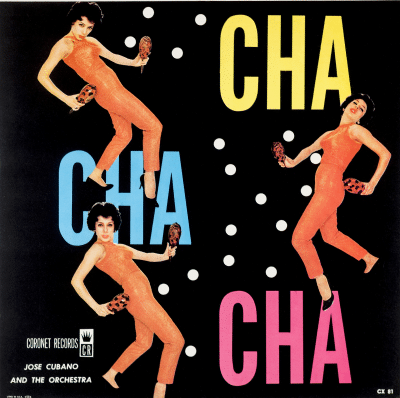
Cha Cha Cha
Jose Cubano and The Orchestra
Coronet CXS 81; 1961
.
…..The cover for Jose Cubano and the Orchestra’s Cha Cha Cha is a striking, if clichéd, example of the genre. Bold typographic Cha’s in bright red, yellow, and blue mingle with three photographs of the same dancer, dressed a bit unusually in matching pants and sleeveless top, maracas in hand, making her moves. White dots – winding their way through the cover – suggest a dance diagram. The notes, too, seem typical. They begin with a nugget about dancing the cha-cha-cha: “Although its provocative rhythm lends itself to intricate variations, the Cha Cha is easily learned, even by the novice dancer.” They tell a tale of one Jose Cubano, the son of “the famous dance team of Julio and Dolores,” who introduced him to “the latin beat.”
…..But the story reads suspiciously like fake news. Indeed, we discovered that Jose Cubano is a made-up persona. This practice is common enough for budget labels. However, Cubano’s liner note back story is complete with parents (Julio and Dolores), details about his New York band, and mention of “his best known Cha Cha’s.” With a little sleuthing (thanks to Shazam’s music identification application), we determined that Cha Cha Cha comprises selections from other musicians such as Art Mooney, whose “Kiss Me Again,” and “Toyland” are here. Papito Pavon and His Orchestra (another stage name?) contribute “Palm Tree Cha Cha” – listed on the LP as “La Sorella.”
.
.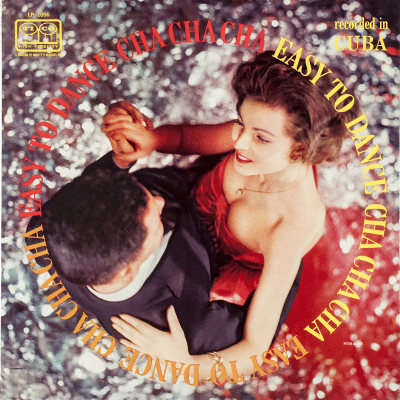
Easy to Dance Cha Cha Cha
Neno Gonzalez and His Orchestra
Tico Records LP 1056; 1959
.
…..“Recorded in Cuba,” Easy to Dance Cha Cha Cha, with Neno González and His Orchestra presents a dancing couple photographed from above, affording a view of the woman’s face and bosom, bound into a red satin dress, while the tuxedoed man’s face is largely out of view. (The shot is by Peter Oliver, a fashion photographer who produced a few album covers, most focusing on attractive models or stylish portraits.) The title typography circles around them, repeated three times in “hot” Latin colors – yellow, orange, red – suggesting swirling movement and cha-cha-cha rhythm.
…..Released just before the 1959 Cuban revolution, the liner notes reflect a musical landscape that would drastically change, at least for Americans: “The Neno González Orchestra is an aggregation known as a ‘charanga.’ This term applies to Cuban dance bands who play the numerous dance halls and casinos that dot the island.” The notes, in English and Spanish, emphasize: “Dancing is always fun and the uncomplicated manner in which this authentic Cuban orchestra lays down the beat makes the cha cha cha even more fun and….so very ‘easy to dance’.” Numbers include “La Reina Del Caribe (Queen Of The Caribbean)” and “La Tierra Del Cha Cha Cha (The Land Of The Cha Cha Cha)”
.
.
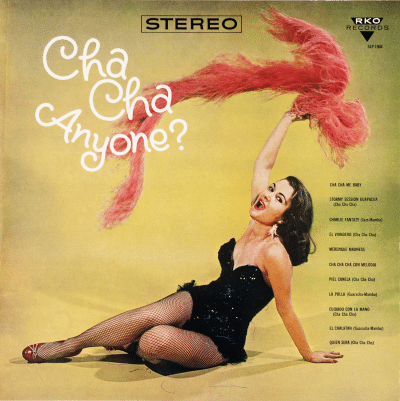
Cha Cha Anyone?
Paquitin Lara And His Latin American Orchestra/Ramon And His Orchestra
RKO Records, SLP-1004; 1958
.
…..The cover for Cha Cha Anyone? brings up burlesque. A few pink feathers from her boa scatter around the dark-haired model who sits, mouth wide open, with fish-netted legs crossed. Dancing-girl thrill seemingly usurped by the new rhythms and steps, she seems adrift on the cover.
…..Joining in the celebratory hype, the album includes a selection of cha chas, mambos, and merengues by two different groups: “The phenomenal rise in popularity of the Cha Cha Cha within the last ten years has been unparalleled in dance history.” The notes include a brief biography of Paquitin Lara, who leads the band on side one. The band on side two lists as “a group of young Puerto Rican musicians,” led by “Ramon.” In any case, the music is good (Cha Cha Anyone? was released as a CD under the title Latin Heat). The first side, with “Cha Cha Cha Me Baby” and “Stormy Session Guapacha” (guapacha refers to alternative Cha Cha dance rhythm) offers a few vocal numbers interspersed with standard cha chas. Standouts include “Piel Canala,” with very interesting chiming guitar and a powerful version of the classic “Quien Sera” by Ramon and his Puerto Rican musicians. (“Quien Sera,” was adapted into English as “Sway” and recorded by many performers, from Dean Martin to The Pussycat Dolls, and is often recruited by film and television music supervisors to inject a bit of “heat” to the soundtrack.) The notes strike a dissonant tone, steeping the unnamed musicians in a vision of the “childlike native” getting “carried away by their own enthusiasm, bursting into song and shouts when the fancy strikes them.” In fact, such vocalizations were standard for cha cha orchestras since Jorrín.
.
.
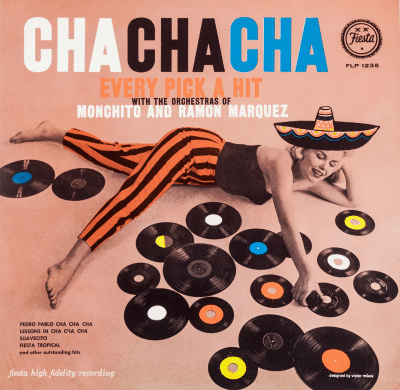
Cha Cha Cha: Every Pick A Hit
Ramon Marquez And His Orchestra/Monchito And His Orchestra
Fiesta FLP 1235; 1959
.
…..The Every Pick A Hit cover gal also appears, sans sombrero, on Pic-a-Polka from Piknic records – same striped pants, bare feet, and scattered records. In fact, the cover photo is identical. Only here, on Cha Cha Cha, designer Victor Mikus adds the colorfully illustrated millinery detail to suggest that the discs scattered across the floor aren’t just any pop or polka platters, but recordings with that South of the Border beat, turning standard tunes into “Lessons in Cha Cha Cha,” with a “Uno Dos Y Tres,” and “A Little Bit of Mambo.” Bright overlaid orange, yellow, and blue highlight labels and define space where the model, in bold tangerine capris, finds her body pinned between title lettering and an encroaching brigade of black vinyl. Mikus designed dance-focused covers for Armando Valdespi And His Orchestra’s Let’s Dance; The Candymen Orchestra’s Let’s Twist Volume II; and Randy Carlos And His Orchestra’s Ajá! Pachanga.
…..The musicians on this LP are outstanding: it’s easy to understand how the rhythm swings and the vocals might inspire dancing. Monchito, born Raymond Muñoz Rodriguez in San Juan, Puerto Rico, drummed in his father’s orchestra when the family moved to New York City. He went on to participate in important RCA recording sessions and play bongos for Tito Puente and timbal for Tito Rodriguez in the 1950s. Ramón Márquez Carrillo, born in Guadalajara, Mexico, was an esteemed musician – playing trumpet and trombone – and also a composer credited with creating a rhythm called Chivirico.
.
.
___
.
.
The authors have created a Designed for Dancing: “Cha-cha-cha” playlist on Spotify. It can be accessed by clicking on the playlist below, or by clicking on this link.
.
.
.
.
___
.
.
photo by Ria Tafani
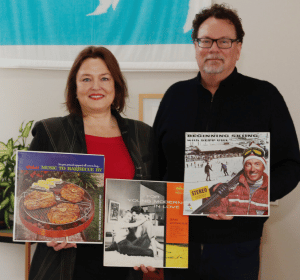
Janet Borgerson and Jonathan Schroeder, authors of Designed For Dancing: How Midcentury Records Taught America to Dance [MIT Press]
.
Ms. Borgerson is Wicklander Fellow at DePaul University. Mr. Schroeder is William A. Kern Professor in the School of Communication, Rochester Institute of Technology. They are the authors of Designed for Hi-Fi Living: The Vinyl LP in Midcentury America (MIT Press), named a best book of 2017 by the Financial Times and a best music book of 2017 by Vinyl Factory.
.
.
___
.
.
Click here to visit the book’s website
Click here to read “Outtakes” Vol. 1
Click here to read the Jerry Jazz Musician interview with Janet Borgerson and Jonathan Schroeder
.
.
___
.
.
Click here to subscribe to the Jerry Jazz Musician quarterly newsletter
Click here to help support the ongoing publishing efforts of Jerry Jazz Musician
.
.
.




